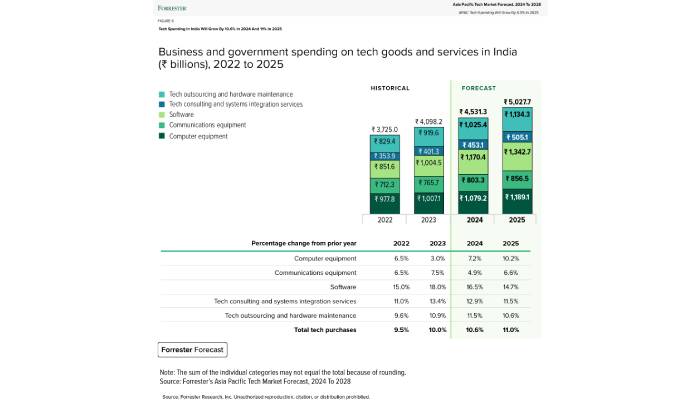New forecast pegs India’s IT investment at ₹5 trillion; experts say tech is now central to business growth, even in traditional sectors
Despite escalating economic headwinds stemming from geopolitical tensions and fresh US tariffs, India is expected to emerge as the undisputed leader in technology spending across the Asia Pacific (APAC) region. According to Forrester’s latest Asia Pacific Tech Market Forecast (2024–2028), while regional growth may be trimmed by up to two percentage points, India stands firm with a projected ₹5 trillion (US$59 billion) tech investment in 2025.
This bullish outlook on India reflects not just optimism, but a measured confidence in the nation’s structural strengths, its digital-first policy initiatives, and a proactive private sector embracing emerging technologies like artificial intelligence (AI), cloud computing, and advanced cybersecurity.

“The future belongs to those who innovate responsibly and invest wisely.”
— Ajay Yadav, Head – IT & Security, SBL Homoeopathy
A Complex Regional Outlook
Forrester’s revised forecast indicates that the broader APAC region will see moderated IT investment due to tariff-induced trade disruptions and inflationary cost pressures, especially in supply chain-dependent markets. The original forecast of 6.5% annual growth is now expected to be reduced slightly as businesses reassess priorities.
However, India defies this regional cooling with sustained double-digit growth in core segments such as enterprise software, AI solutions, hybrid cloud deployments, and IT consulting services. The Forrester report highlights that software spending alone is set to grow by 10.4% across the region, with India contributing significantly to this surge.
India’s Digital Flywheel Effect
A multitude of factors are fueling India’s outlier performance. Chief among them is the nation’s expansive and fast-digitizing domestic economy. With a population of over 1.4 billion and growing smartphone and internet penetration, the demand for digital services continues to skyrocket across healthcare, education, financial services, manufacturing, and agriculture.
“Resilience in cybersecurity is the cornerstone of digital acceleration.”
— Sandeep Karan, Head Cybersecurity, L&T Technology Services

“The country’s large domestic market acts as a strategic buffer against global volatility,” notes Ashutosh Sharma, VP and Research Director at Forrester. “India’s aggressive adoption of emerging technologies and its increasing AI capabilities position it as a critical player in global tech innovation.”
Indeed, India’s digital economy has entered an inflection point. Government-driven programs like Digital India, Smart Cities Mission, BharatNet, and PM GatiShakti are enabling digital infrastructure modernization at scale. Simultaneously, initiatives such as ONDC (Open Network for Digital Commerce) are democratizing e-commerce and digital trade, while UPI (Unified Payments Interface) continues to revolutionize the fintech landscape.
Ajay Yadav, Head – IT & Security at SBL Homoeopathy, affirms this trend from an industry perspective:
“At SBL Homoeopathy, we are witnessing firsthand how even traditional sectors like homoeopathy pharmaceuticals and healthcare are being transformed by technology. From deploying AI in operational processes to securing our digital infrastructure with next-gen cybersecurity solutions, tech is not just a support function—it’s a business enabler.”

“The Indian enterprise is rapidly evolving—from compliance-focused IT departments to technology-driven business enablers.” – Sandiip Kothaari, CTO of Speciality Group
According to Yadav, the surge in IT spending mirrors a broader mindset shift in Indian enterprises:
“India’s ability to outpace other APAC economies in tech investment speaks volumes about our long-term digital maturity. However, to sustain this trajectory, enterprises must focus on building robust cybersecurity frameworks, nurturing tech talent, and aligning IT strategy with business goals.”
The Cybersecurity Imperative
Cybersecurity has emerged as a defining priority in India’s tech evolution. With digitization comes the parallel challenge of protecting vast volumes of sensitive data and critical infrastructure from increasingly sophisticated cyber threats.
Sandeep Karan, Head of Cybersecurity at L&T Technology Services, underscores the urgency:
“Resilience in cybersecurity is the cornerstone of digital acceleration. As enterprises integrate AI, IoT, and edge computing into their operations, they must also recalibrate their security postures to be adaptive, predictive, and proactive.”
“India’s digital economy is on an accelerated path, but CIOs must brace for volatility in global trade dynamics.”
— Ashutosh Sharma, VP & Research Director, Forrester

Karan believes the tech investment boom must be underpinned by a “security-first mindset” that permeates not just IT teams but also C-suite decision-making.
“We’re seeing a shift from compliance-led security to business-integrated cybersecurity strategies. Enterprises must balance innovation with vigilance, embedding security at every layer—from application development to supply chain operations.”
This view is echoed by Frederic Giron, VP and Senior Research Director at Forrester, who warns CIOs to prepare for tariff-era disruptions:
“Asia Pacific’s tech spending growth continues to demonstrate the region’s commitment to leveraging technology for resilience. But economic headwinds require CIOs to stay agile, reprioritize initiatives, and build adaptive, future-ready IT strategies.”
“The Indian enterprise is rapidly evolving—from compliance-focused IT departments to technology-driven business enablers,” says Sandiip Kothaari, CTO of Speciality Restaurants Ltd. “Even in traditional sectors like hospitality and food services, we’re seeing a transformation driven by cloud platforms, AI-driven customer analytics, and cybersecurity modernization.”
According to Kothaari, the shift is more than just technology adoption—it’s a business survival imperative:
“In today’s environment, you either digitize deeply or risk obsolescence. We’re investing in AI for predictive insights, automating kitchen-to-customer workflows, and fortifying cyber defenses to ensure trust and continuity.”
Generative AI, Cloud, and Analytics Take Center Stage
One of the most promising areas for tech investment is AI—particularly generative AI. Forrester notes that enterprises across India and Southeast Asia are allocating significant budgets to deploy AI for customer insights, process automation, and intelligent decision-making.
India is emerging as a global center for AI development, supported by a vast IT services industry, strong academic partnerships, and a thriving startup ecosystem. Indian IT giants and SaaS firms are rolling out enterprise-ready AI platforms, while vertical-specific AI use cases—such as predictive maintenance in manufacturing or intelligent diagnosis in healthcare—are fast gaining traction.

“CIOs must stay agile and prioritize adaptive IT strategies to mitigate economic shocks.”
— Frederic Giron, VP & Senior Research Director, Forrester
Cloud adoption is another pillar of growth. The move towards hybrid cloud and multi-cloud strategies is driving spending in infrastructure modernization, data governance, and cloud-native application development.
In tandem, there is growing investment in analytics and business intelligence platforms to harness the data deluge generated by these technologies. CIOs are focusing on extracting actionable insights, improving time-to-decision, and enhancing operational efficiency across the board.
Southeast Asia’s Rapid Digitization
While India takes the lead, Southeast Asian nations are also making significant strides. The Forrester forecast lists Vietnam (10%), Philippines (9.4%), and Indonesia (8.5%) among the top performers in APAC tech spending, thanks to aggressive digitization in government and enterprise sectors.
China, still the region’s largest IT spender, is projected to grow at 7.7%, reaching US$264 billion in 2025. Much of this will be state-driven investment in AI, semiconductor self-reliance, and national security technologies. Australia (6.6%) and Singapore (5.6%) are also expected to perform steadily due to their innovation-driven policies and mature digital ecosystems.
Strategic Takeaways for CIOs and Policy Leaders
The Forrester report, combined with industry perspectives, offers a set of key imperatives for IT leaders navigating this volatile but opportunity-rich environment:
- Embrace Scenario Planning: CIOs should prepare for tariff-related disruptions with supply chain visibility tools, diversified sourcing, and flexible vendor strategies.
- Invest in AI and Automation: Early adoption of AI, especially in service delivery, analytics, and process optimization, will yield long-term competitive advantage.
- Build Cyber Resilience: Security must evolve from perimeter-based defense to holistic, adaptive frameworks that integrate zero trust, data protection, and threat intelligence.
- Align Tech with Business Goals: IT must operate as a strategic partner to the business, co-driving growth, innovation, and customer experience.
- Focus on Talent Development: Upskilling the workforce in digital, AI, and security skills is crucial to sustaining innovation momentum.
Conclusion
The convergence of strategic policy, private sector dynamism, and global investor confidence is propelling India to the forefront of technology spending in the Asia Pacific region. Amidst global volatility, India’s robust digital transformation initiatives, demographic dividends, and entrepreneurial spirit offer a template for resilient, inclusive, and innovation-led growth.
As Ajay Yadav rightly puts it, “The future belongs to those who innovate responsibly and invest wisely in technology as a core pillar of growth.” And as India steps into this leadership role, the rest of the region—and indeed, the world—will be watching closely.




